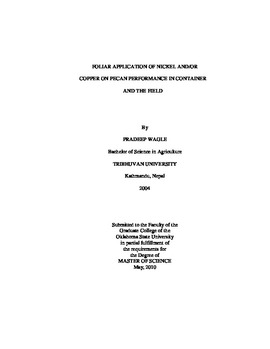| dc.contributor.author | Wagle, Pradeep | |
| dc.date.accessioned | 2014-04-15T22:32:30Z | |
| dc.date.available | 2014-04-15T22:32:30Z | |
| dc.date.issued | 2010-05-01 | |
| dc.identifier.uri | https://hdl.handle.net/11244/9596 | |
| dc.description.abstract | Nickel (Ni) shortage is more likely for ureide-nitrogen transporting crops like pecans [Carya illinoinensis (Wang.) K. Koch]. Soil pH in the Red River basin is near neutral or alkaline restricting the availability of many nutrient cations such as zinc (Zn), copper (Cu) and Ni. Nickel and/or Cu treatments were applied as a foliar application at the parachute stage of leaf development followed by two additional applications at two week intervals. The objectives of the study were to 1) evaluate the interaction between (nitrogen) N rate and foliar Ni application on growth of container-grown pecan seedlings, 2) determine the response of bearing pecan trees to foliar Ni application, and 3) assess the impact of foliar Ni and Cu treatments to mitigate the problems associated with excess N. Leaf Ni concentration of 3 μg g-1 dry weight met pecan tree's Ni requirement if leaf Zn and Cu concentrations were within or near the established sufficiency ranges. No benefits from additional Ni beyond the critical level were detected on tree yield, nut quality, tree growth, and N metabolism. Positive responses to essential elements are common when an element is in short supply but visible symptoms are not present. This is termed "hidden hunger" in many texts. Our results indicate that the range between hidden hunger and becoming symptomatic is narrow for Ni. It was hypothesized that excess N may be exacerbating kernel necrosis, necrotic tissues at the basal end of kernel, at Tim Montz's orchard where trees derive an unusually high amount of N from nitrate contaminated irrigation water. The supplemental applications of Ni and Cu may enhance growth and production in this orchard via improved Ni and Cu nutrition and by mitigating any negative effects associated with excess N. Although Ni and Cu treatments reduced leaf N, kernel necrosis was unaffected by treatment. The cause of kernel necrosis remains unknown. The effects of Ni and/or Cu treatments on tree yield, nut quality, and tree growth were inconsistent. | |
| dc.format | application/pdf | |
| dc.language | en_US | |
| dc.publisher | Oklahoma State University | |
| dc.rights | Copyright is held by the author who has granted the Oklahoma State University Library the non-exclusive right to share this material in its institutional repository. Contact Digital Library Services at lib-dls@okstate.edu or 405-744-9161 for the permission policy on the use, reproduction or distribution of this material. | |
| dc.title | Foliar Application of Nickel and/or Copper on Pecan Performance in Container and the Field | |
| dc.type | text | |
| osu.filename | Wagle_okstate_0664M_10790.pdf | |
| osu.college | Agricultural Sciences and Natural Resources | |
| osu.accesstype | Open Access | |
| dc.description.department | Horticulture and Landscape Architecture Department | |
| dc.type.genre | Thesis | |
| dc.subject.keywords | carya illinoinensis | |
| dc.subject.keywords | critical level | |
| dc.subject.keywords | kernel necrosis | |
| dc.subject.keywords | leaf elemental concentration | |
| dc.subject.keywords | parachute stage | |
| dc.subject.keywords | yield efficiency | |
